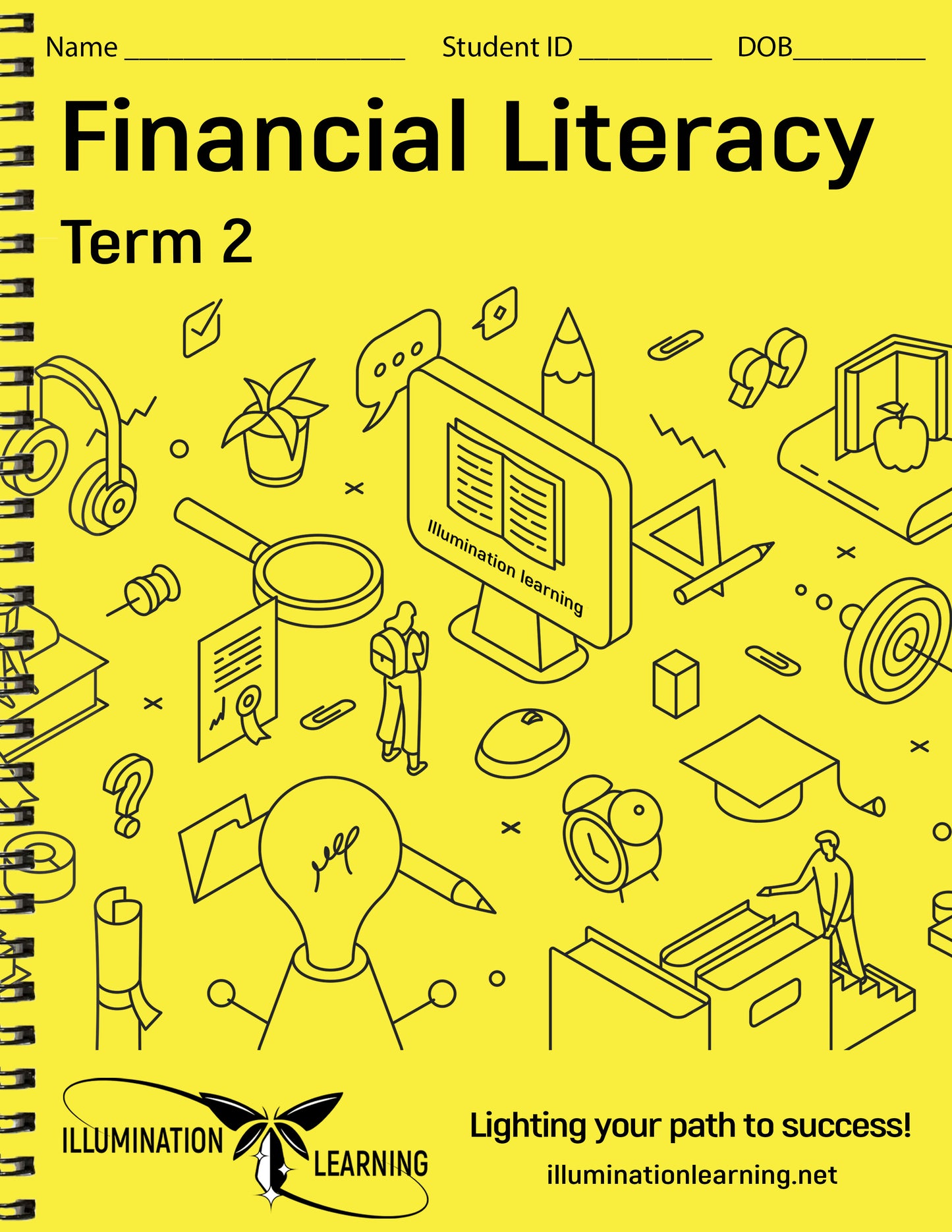ILLUMINATION LEARNING
Financial Literacy 𝘾𝙧𝙚𝙙𝙞𝙩
Financial Literacy 𝘾𝙧𝙚𝙙𝙞𝙩
Couldn't load pickup availability
Financial Literacy – Term 1 - 2 (sold separately)
This workbook course equips high school students with essential knowledge and skills for managing personal finances and making informed financial decisions. Students explore real-world topics such as budgeting, saving, investing, credit, debt, and financial planning to build a strong foundation for lifelong financial stability.
Throughout the two terms, students learn how to create realistic budgets, set financial goals, evaluate financial products, and understand the risks and rewards of credit and investment choices. Topics also include banking basics, taxes, insurance, identity theft prevention, and strategies for avoiding financial pitfalls such as excessive debt and bankruptcy.
By the end of the course, students will be empowered to take control of their financial futures with confidence. Financial Literacy prepares students to navigate adult responsibilities, avoid common financial mistakes, and build habits that promote economic security and personal success.
Click Here for a Sample Chapter!
__________________________________________________________________________________
Financial Literacy Term 1
1. Understanding Money and Income
1.1 Introduction to Financial Literacy
1.2 What is Money?
1.3 Types and Forms of Money
1.4 The History and Evolution of Currency
1.5 Understanding Income
1.6 Types of Income (Earned, Passive, Portfolio)
1.7 Sources of Income
1.8 The Relationship Between Work and Income
1.9 Introduction to Paychecks and Paystubs
1.10 Gross Income vs. Net Income
1.11 Taxes and Deductions
1.12 Written Questions
1.13 Fill in the Blanks
1.14 Multiple Choice Questions
2. Budgeting and Saving
2.1 What is a Budget?
2.2 Importance of Budgeting
2.3 Income vs. Expenses
2.4 Fixed vs. Variable Expenses
2.5 Setting Financial Goals
2.6 The 50/30/20 Rule
2.7 Creating a Personal Budget
2.8 Tracking Spending
2.9 Introduction to Saving
2.10 Short-Term vs. Long-Term Savings
2.11 Emergency Funds
2.12 Interest and Compound Interest
2.13 Saving Accounts and Tools
2.14 Written Questions
2.15 Fill in the Blanks
2.16 Multiple Choice Questions
3. Banking and Financial Institutions
3.1 Role of Financial Institutions
3.2 Types of Financial Institutions
3.3 Opening and Managing Bank Accounts
3.4 Checking vs. Savings Accounts
3.5 How to Write and Deposit Checks
3.6 Online and Mobile Banking
3.7 Debit Cards vs. Credit Cards
3.8 Fees and Charges
3.9 Understanding Bank Statements
3.10 Identity Theft and Fraud Prevention
3.11 Written Questions
3.12 Fill in the Blanks
3.13 Multiple Choice Questions
__________________________________________________________________________________
Financial Literacy Term 2
1. Credit and Loans
1.1 Introduction to Credit
1.2 Types of Credit (Credit Cards, Loans, Lines of Credit)
1.3 How Credit Works
1.4 Credit Reports and Credit Scores
1.5 Building and Maintaining Good Credit
1.6 The Cost of Credit: Interest and Fees
1.7 Loans: Student, Auto, Personal, and Mortgages
1.8 Borrowing Responsibly
1.9 Predatory Lending and Scams
1.10 Written Questions
1.11 Fill in the Blanks
1.12 Multiple Choice Questions
2. Managing Debt
2.1 Understanding Debt
2.2 Types of Debt
2.3 Good Debt vs. Bad Debt
2.4 Strategies for Managing Debt
2.5 Budgeting for Debt Repayment
2.6 Debt Consolidation and Refinancing
2.7 Bankruptcy: What It Is and What It Means
2.8 Avoiding Debt Traps
2.9 Written Questions
2.10 Fill in the Blanks
2.11 Multiple Choice Questions
3. Consumer Skills and Protection
3.1 Making Smart Purchasing Decisions
3.2 Comparison Shopping and Evaluating Products
3.3 Advertising and Media Influence
3.4 Understanding Contracts and Warranties
3.5 Consumer Rights and Responsibilities
3.6 Protecting Against Fraud and Identity Theft
3.7 Online Safety and Financial Security
3.8 Government Agencies and Consumer Protection Laws
3.9 Written Questions
3.10 Fill in the Blanks
3.11 Multiple Choice Questions
Share



